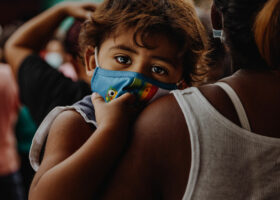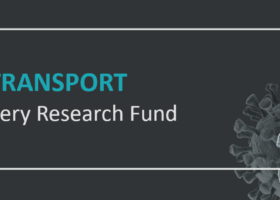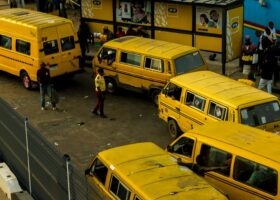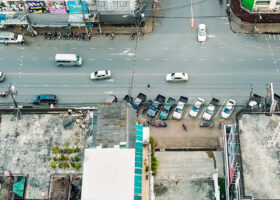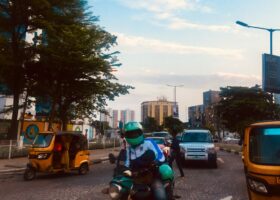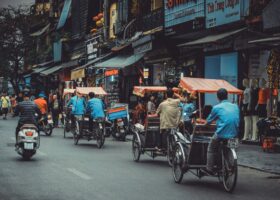Overview
In African cities, walking is the primary mode of transport for the majority of people, with in the order of 78% of people walking for travel every day (UN Environment, 2021). People travel for an average of 55 minutes per day on foot, yet data from nine African countries shows that 74% of roads have no footpaths, 92% no crossings, and 48% are poorly signed and maintained (https://www.irap.org/3-star-or-better). Across the continent, in 2019, some 33% of all road traffic fatalities, and 35% of all daily road injuries, were people walking. The World Road Association’s (PIARC) catalogue of design safety measures estimates that investment in pedestrian facilities could reduce crashes by up to 90% (UN Environment, 2021).
People walk in African cities mostly to save on the high cost of public transport, where between 30-49% of household income might be spent on travel otherwise (Porter, Abane and Lucas, 2020). Where walking is a main mode, this dramatically limits the range within which people may access opportunities and have the needs of their daily life met. Women and children are more likely to walk than are men and therefore are more disadvantaged. Pedestrians also face a bewildering array of challenges, from flooded roads to snakes and other dangerous animals, speeding drivers, construction rubble, potholes, storm drains and raw sewers, physical attacks, and lack of shade and resting places. Often what little space they might have in which to walk is crowded in by informal traders and, at times motorcycle-taxis (boda-bodas). Although walking is regarded as a high-value public health intervention in European and US cities, in African cities the exposure to pollutants and motorised traffic renders this moot, although there are few systematic reviews of the challenge to date (Porter, Abane and Lucas, 2020; Tiwari et al., 2020). As urbanisation picks up pace, attending to the lack of pedestrian infrastructure becomes ever more challenging, because of the need to retrofit the built and the prevailing regulatory environment, but also claim a share of resources where cities are directing more toward big-infrastructure public transport reform (Vanderschuren et al., 2017).
As well as benefiting a billion people’s transport every day (UN Environment, 2021), improving walking facilities will also accelerate the delivery of existing Sustainable Development Goal (SDG) commitments to: increase health and well-being (SDG 3); reduce inequalities (SDG 10); make more inclusive, safe and resilient communities (SDG 11); and mitigate the impacts of climate change (SDG 13).
Publications with the same themes
Publications with the same study countries
Related news & events
News
News
News
News
Blog
News
Blog
PDF content (text-only)
A policy brief for decision makers INVESTING IN WALKING IN AFRICA N CITIES : MOVING BEYOND POLICY June 2021 HVT036 - Walk21 Foundation Photo Credit : Walk21 Foundation 1 POLICY BRIEF: Investing in Walking in African Cities: Moving Beyond Policy 1. Context In African cities, walking is the primary mode of transport for the majority of people, with in the order of 78% of people walking for travel every day (UN Environment, 2021) . People travel for an average of 55 minutes per day on foot, yet data fro m nine African countries shows that 74% of roads have no footpaths, 92% no crossings, and 48% are poorly signed and maintained (https://www.irap.org/3 -star -or-better ). Across t he continent, in 2019, some 33% of all road traffic fatalities, and 35% of all daily road injuries, were people walking . The World Road Associatio n’s (PIARC) catalogue of design safety measures estimates that investment in pedestrian facilities could reduc e crashes by up to 90% (UN Environment, 2021) . People walk in African cities mostly to save on the high cost of public transport, where between 30 -49% of household income might be spent on travel otherwise (Porter, Abane and Lucas, 2020) . Where walking is a main mode, this dramatically limits the range within which people may access opportunities and have the needs of their daily life met. Women and children are more li kely to walk than are men and therefore are more disadvantaged. Pedestrians also face a bewildering array of challenges, from flooded roads to snakes and other dangerous animals, speeding drivers, construction rubble, potholes, storm drains and raw sewers, physical attacks, and lack of shade and resting places. Often what little space they might have in which to walk is crowded in by informal traders and, at times motorcycle -taxis (boda -bodas). Although walking is regarded as a high -value public health inte rvention in European and US cities, in African cities the exposure to pollutants and motorised traffic renders this moot, although there are few systematic reviews of the challenge to date (Porter, Abane and Lucas, 2020; Tiwari et al. , 2020) . As urbanisation picks up pace, attending to the lack of pedestrian infrastructure becomes ever more challenging, because of the need to retrofit the built and the prevailing regulatory environment, but also claim a share of resources where cities are directing more toward big -infrastructure public transport reform (Vanderschuren et al. , 2017) . As well as benefiting a billion people’s transport every day (UN Environment, 2021) , improving walking facilities will also accelerate the delivery of existing Sustainable Development Goal (SDG) commitments to: increase health and well -being (SDG 3); reduce inequalities (SDG 10); make more inclusive, safe and resilient communities (SDG 11); and mitigate the impacts of climat e change (SDG 13) . 2. Method and purpose This Brief takes as its starting point that walking in African cities is currently inadequately understood and planned for, invested in, and supported through policy and other measures (Figueroa, Fulton and Tiwari, 2013; Behrens et al. , 2016; Vanderschuren et al. , 2017; Jennings et al. , 2019, 2019; Porter, Abane and Lucas, 2020; Tiwari et al. , 2020; Benton, Jennings and Walker, 2021) . Only 19 out of 54 African countries have developed walking (usually referred to as NMT, or Non -Motorised Transport) policies and plans in recent years, whether as singular documents or part of broader transport plans (UN Environment, 2021) . Only t wo countr ies in Africa have country -specific pedestrian infrastructure guidelines (Uganda and South Africa). Yet given the scale of walking as a majority mode of travel in cities in Africa and the extent of its risk for pedestrians in terms of road crashes and fat alities (along with its importance in mitigating obesity, poor air quality, climate change, and road congestion ), walking is a mode that will gain rather than lose in importance as African cities become more congested and struggle to meet mobility needs. The purpose of the Brief is therefore to describe ways in which walking can be more effectively valued and embedded into policy and commitment at loc al and national levels. It is based on a full report titled ‘Our Walking is Our Asset: Exploring the way in which walking is valued in pedestrian practice and policy in African cities’ (Benton, Jennings and Walker, 2021) . This research was funded by UKAID throug h the UK Department for International Development under the High Volume Transport Applied Research Programme, managed by IMC Worldwide. 3. Key challenges to planning for walking For th e full report , we conducted a literature review on work publish ed about walking in Africa, sourced from both scholarly work and grey literature published within the last ten years, and also collected two sets of primary data through an online survey and through in-depth semi -structured interviews . Participants from government authorities, non -government organisations, universities and funding bodies were included. Questions focused on 2 POLICY BRIEF: Investing in Walking in African Cities: Moving Beyond Policy how walking is currently valued in transport policy and practice in Africa, and what the most effective ways to bett er value and secure resources for walking might be. The following concerns were commo n to the majority of interviews and survey participants: • Many transport decision makers in Africa currently under -value walking because, unlike other transport investment choices, it is seen as unable to create income or attract investment. • People walking are often perceived as poor and having a lower value of time compared to car users, resulting in a general lack of respect, lower priority in decisions , and sense of irr elevance to the aspirational transport system of the future. • There is a consensus of concern that unless these values change , the consequence s of motorisation will have a significant negative impact on Africa’s social, environmental , and economic future. • Over the last five years, more than a third of African countries have developed a transport policy that include commitments to improving conditions for people walking. However, many decision -makers report that the policies are ineffective because too often they are yet to be translated into action. • A lack of capacity and knowledge are more significant beyond major cities , i.e. , in the smaller towns and rural areas. • Retaining current high pedestrian mode shares and providing safer facilities should be high on the agenda of decision -makers. • Several key informants believe there is sufficient funding for sustainable mobility in Africa , but that competing priorities (that don’t currently count the necessity to walk safely as an essential element requiring investment) are limiting the efficacy of the whole transport system. 4. Recommendations for action Findings from the primary research referred to above suggest that a redefinition of a successful mobility system would help transform the way that walking is valued in Africa. The study on which this brief is based revealed that it is the imbalance of funding, rather than just the overall availability of funding, that is a major constraint for African city authorities. Th ese findings have three key implications for policy, practice and research to better support walking: 1. An Africa -relevant framework for evaluating transport investment impact would help rebalance the prioritisation of funding , to deliver improvements that w ould retain and protect current pedestrians and possibly attract new people to walking as a transport mode . 2. Establishing methods for evaluating the walking experience and understanding the needs of pedestrians – beyond a simple concept of ‘road safety’ and ‘time saving’ – would help inform a new approach to providing for pedestrians. This includes: Setting indicators for measuring the value of walking and the impact of investments on the walking experience ; Collecting a broader set of data (both quantitative and qualitative data) on people walking ; and Engaging low -income communities more in sharing what they need and how to improve their walking experience. 3. Training and capability building to develop the tec hnical expertise and know -how to implement policies and effective solutions on walking are critical to enable the efficacy of investment . This includes : Supplementing gaps in knowledge with external expertise and support and exchange experiences across Africa to grow capability ; and Demonstrating outcome impacts on the safety, accessibility and comfort of the walking experience through rigorous pilot and demonstration projects. 3 POLICY BRIEF: Investing in Walking in African Cities: Moving Beyond Policy 5. References Behrens, R. et al. (2016) Mobility and access in Sub -Saharan African cities: The state of knowledge and research environments . VREF, Mobility and access in African Cities. Benton, J., Jennings, G. and Walker, J. (2021) ‘Our walking is our asset’: exploring the way in which walking is valued in pedestrian practice and policy in African cities . High Volume Transport Applied Research UKAID. Figueroa, M., Fulton, L. and Tiwari, G. (2013 ) ‘Avoiding, Transforming, Transitioning: Pathways to Sustainable Low Carbon Passenger Transport in Developing Countries’, Current Opinion in Environmental Sustainability , 2(5), pp. 184 –90. https://www.irap.org/3 -star -or-better/ (no date). Jennings, G. et al. (2019) Scoping study: Transport and social exclusion in African Cities - South Africa Scoping Study Report . VREF, Intalinc. Porter, G., Abane, A. and Lucas, K. (2020) User diversity and mobility practices in Sub -Saharan African cities: understanding th e needs of vulnerable populations . VREF, Mobility and Access in African Cities. Tiwari, G. et al. (2020) Road traffic injury and transport -related air quality in Sub -Saharan Africa: the extent of the challenge . VREF, Mobility and Access in African Cities. UN Environment (2021) Walking and Cycling Global Outlook Report: African Edition . Vanderschuren, M. et al. (2017) ‘Challenges and Opportunities for Non -Motorized Transport in Urban Africa’, in Non -Motorized Transport Integration into Urban Transport Planning in Africa . First. New York: Routledge. This research was funded by UKAID through the UK Foreign, Commonwealth & Development Office under the High Volume Transport Applied Research Programme, managed by IMC Worldwide. The views expressed in this Policy Brief are those of the authors and do not necessarily reflect the UK government’s official policies, nor those of any individuals and organisations referred to in this policy guidance note. IMC Worldwide Ltd, the HVT Programme and the UK government shall not assume any responsibility for the resul ts of works based on the use of this Policy Brief. Users accept this publication is a guidance document only. Users accept that they need to take their own technical and legal advice before issuing Agreements, Terms and Conditions and other legally binding documentation related to implementing any recommendations. The data collection, consultation and other research processes used to create this policy brief have been subject to the necessary data protection regulations and requirement s operating in the relevant countries where the research was conducted. All due diligence has been undertaken to ensure that data sources and statistics quoted have been appropriately aggregated so as to remain anonymous and not to identify any individual. Personal data has only been processed or used for specific and legitimate purposes. Walk21 Foundation 24 Moorend Road Cheltenham Gloucestershire, UK. Tel: +44 7801 334 915 Email: network@walk21.com Web: www.walk21.com




